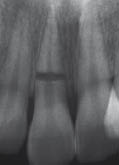(b) 
Diagnosis and treatment planning
A diagnosis of a root fracture was reached for the 11. The treatment plan was to re-position the fractured, previously avulsed coronal segment, and splint the tooth for 3 months.
What is the probability that a root fracture will heal?
Root fractures have been known to heal spontaneously without any intervention by dentists. These are probably the types of fractures that occur from mid-root to the apical one-third of the root, and in which separation between the fractured segments is minimal. In general, root fractures have a high rate of successful healing if they are managed correctly. This involves re-positioning and stabilization of the displaced coronal segment with a splint to promote healing of the periodontal ligament (PDL).
Ideal healing of a root fracture involves deposition of hard tissue (probably cementum) in the coronal segment and at the fracture site. Radiographically, successful healing will reveal radiographic signs of the pulp space narrowing, particularly in the coronal pulp and, to a lesser extent, in the apical root canal. There will be no radiographic signs of disease at the fracture site.
When is root canal treatment indicated for a tooth with root fracture?
Endodontic treatment is indicated when healing does not occur following root fracture; this may be confirmed by the presence of a periradicular radiolucency at the fracture site. In addition, there may be symptoms of pulp necrosis (e.g. pain, discolouration, sinus tract, negative response to sensibility testing). The reason that the periradicular radiolucency is located adjacent to the fracture site is because the pulp necrosis and infection is limited to the coronal segment of the tooth. The apical portion of the root canal remains vital.
Treatment of a tooth with a root fracture, in which the pulp in the coronal segment has become necrotic, consists of root canal treatment confined to the coronal segment of the tooth only. The root canal diameter at the fracture site is usually quite large, even in fully developed, mature teeth. For this reason, the methods of root canal treatment are similar to those used for teeth with open apices and necrotic pulps. The use of mineral trioxide aggregate (MTA) as an apical root filling plug is gaining popularity.
Can a tooth with root fracture be moved orthodontically?
This question frequently arises because traumatic dental injuries tend to occur to patients around the age when orthodontic treatment is optimally and commonly provided. If orthodontic movement is initiated shortly after the fracture occurs, there is a risk that only the coronal portion of the tooth will move. If, however, hard tissue healing has occurred at the fracture site and in the pulp space, orthodontic forces applied to the tooth will move the entire tooth. Nevertheless, it would be prudent to monitor the tooth movement radiographically throughout orthodontic treatment.
Treatment
Stay updated, free dental videos. Join our Telegram channel

VIDEdental - Online dental courses


